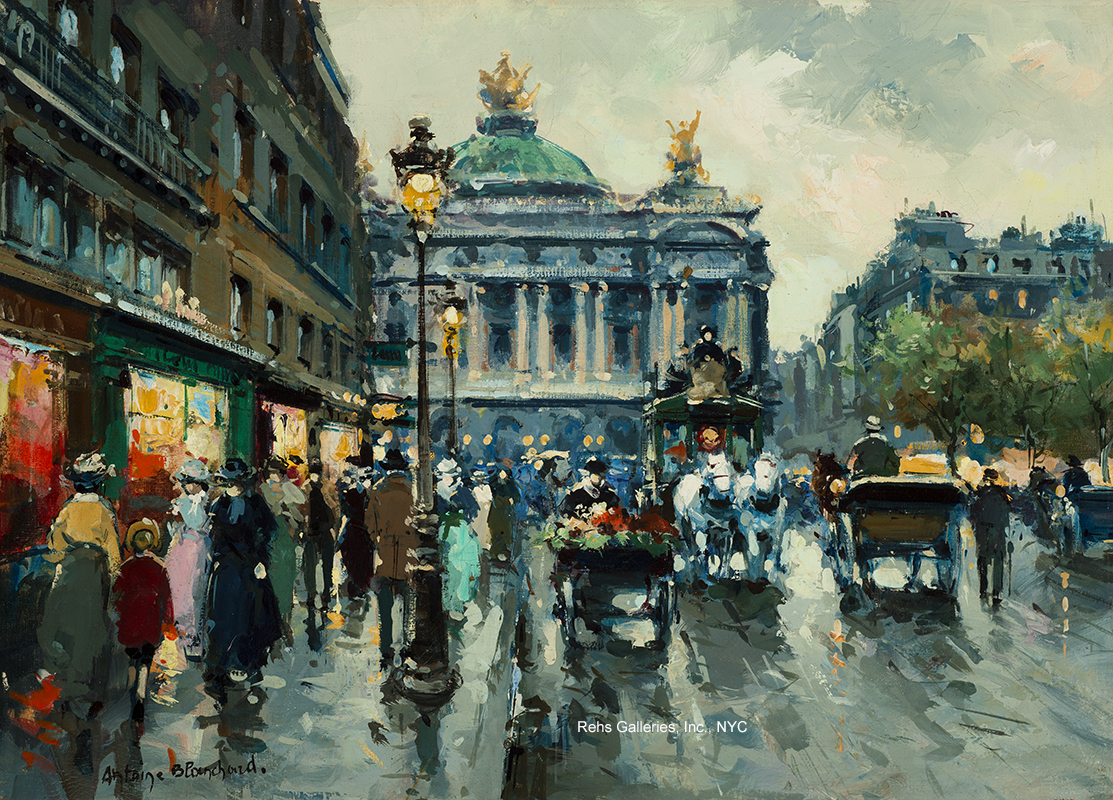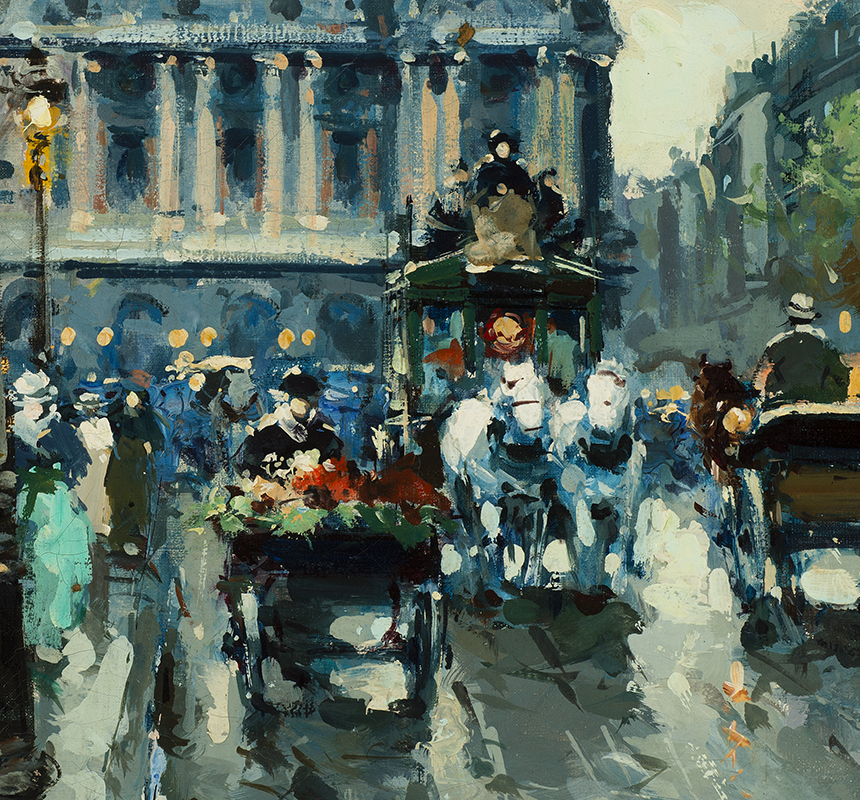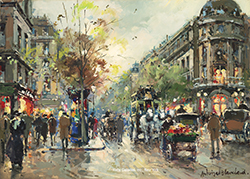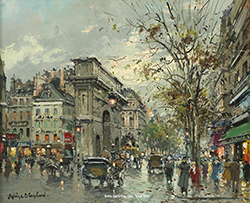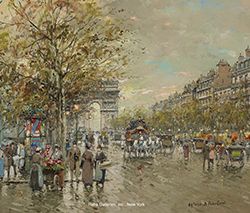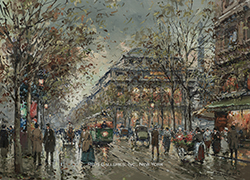Antoine Blanchard
(1910 - 1988)
Avenue de l'Opera
Oil on canvas
15 x 21 inches
Signed
BIOGRAPHY - Antoine Blanchard (1910 - 1988)
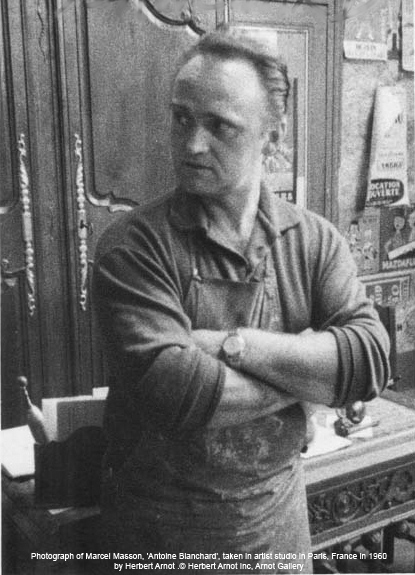
Antoine Blanchard, whose real name was Marcel Masson, was born in France on November 15, 1910 in a small village near the banks of the Loire. He was the eldest of three children and his father, a carver, managed a small carpentry and furniture shop. Antoine would watch his father hand carve the furniture and began to display an artistic flair early in life – in an effort to promote this talent, his parents sent him to Blois for drawing lessons. He continued his training in Rennes at the Ecole des Beaux-Arts where he studied sculpture and drawing. Upon completion of his studies, he was awarded the schools highest award: Le Prix du Ministre.
By 1932 he left Rennes and traveled to Paris to study. He enrolled at the Ecole des Beaux-Arts and after a few years entered the competition for the Prix de Rome. It was in Paris that he developed a love for the city and it’s street life.
In 1939 Antoine married a young woman he met in Paris and in September of that year war broke out and he was called up for service. It was not until 1942 that he would return to his art. His daughter Nicole was born in 1944 - she too would follow in the family tradition and after the birth of her two daughters, she became an artist working under the name A. Champeau. It was also around this time that Antoine’s father passed away and he was compelled to return to his hometown and run the family business – giving him little time to paint.
His second daughter, Evelyn, was born in 1947 and by 1948 he had given control of the family business to his younger brother and returned to Paris to paint. Contemporary life in Paris had changed and he longed for the bygone days. He began to research the Belle Époque period in Paris – reading and studying all the material on the period he could find.
Many of the subjects and scenes he portrayed were taken from images he collected of Paris during the 1890’s and he would often work on paintings for days or months before he finally felt they were complete. Mrs. Paule Larde comments in her book Antoine Blanchard, His Life His Work that he has always spent much time on his work. This explains why his production has always been rather limited, unlike the hurried and multiple proliferations of some modern artists… Delicate touches of luminous and shimmering tones produce a marvelous impression of harmony, brightness and light. Alternate shadings and lights, sensitive and mellow blending allow the artist to attain a hardly-ever reached degree of grace, of radiant and glimmering freshness.
Larde continues to write that his works are first of all, a marvelous invitation to an ideal walk through old Paris, so different from that of to-day. Although a large number of historical monuments remain, today’s Paris has little in common with Paris at the turn of the century; the scenery may be almost the same, but daily life as it characters has totally changed; the customs have been entirely transformed. In his paintings, Antoine Blanchard invites us to relive this period by showing us pleasant strolls along embankments, squares and boulevards at a period in Parisian life when time did not count, when one had all one’s time to idle, to stroll along the streets, to window-shop, to walk quietly along the boulevards or spend the afternoon in a sidewalk café.
Like his contemporary, Edouard Cortès, he devoted his artistic career to the depiction of Paris through all its daily and seasonal changes. But he was not an imitator of Cortes, but rather depicted the life of Paris at the turn of the century from his own point of view and with his own, unique style. Larde makes an interesting comparison:
Edouard Cortès has always expressed himself in a rather rich virile style, using large and stressed touches, revealing a strength, which recalls the great masters of the XVIIIth century.
On the contrary, Antoine Blanchard has always used small strokes, with a delicate, enveloping and mellow treatment; the slight haziness which is a characteristic of his work in many ways recalls the great masters of the impressionist period.
Whether it was l’Arc de Triomphe, la Madeleine, Café de la Paix, Notre Dame or the dozens of other historical monuments and buildings of Paris, his focus was on the daily life of Paris at the turn of the century. His work became highly sought after and collectors from around the world vied to acquire his new works. Blanchard continued to paint until his death on August 10, 1988.
We wish to thank H. Arnot Gallery for the photo of Antoine Blanchard which was taken by Mr. Arnot in 1959
| AVAILABLE WORKS | |||||

